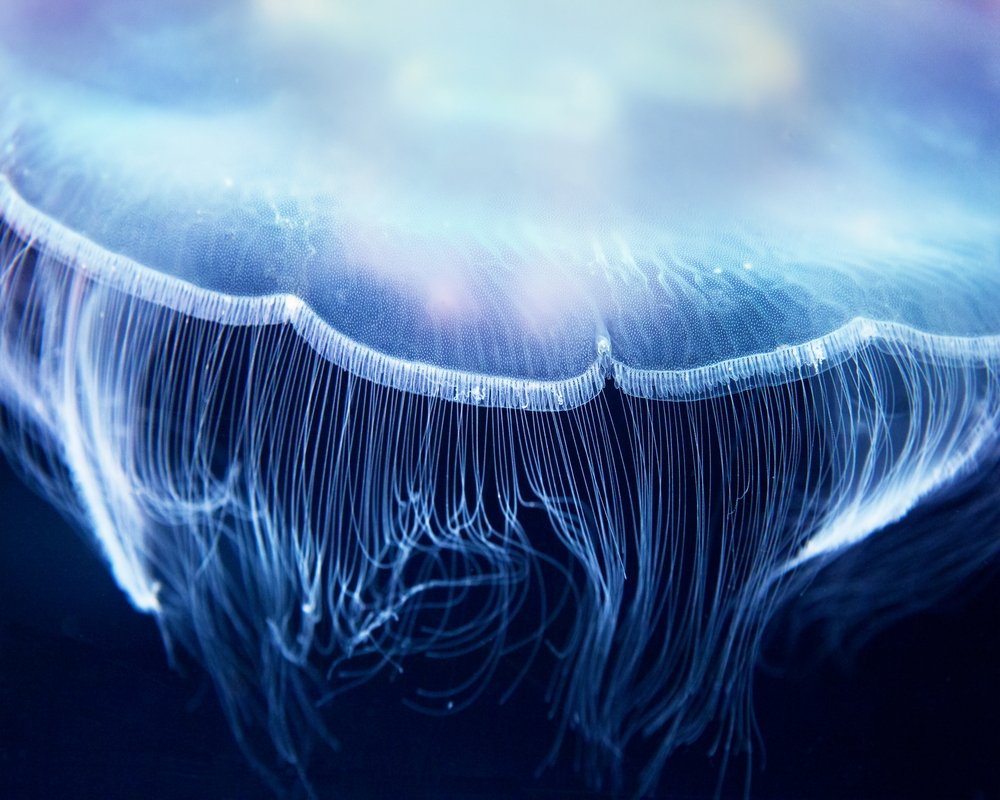The moon jellyfish, scientifically known as Aurelia aurita, is a captivating marine creature renowned for its translucent, moon-like bell. This fascinating species can be found in oceans around the globe, thriving in both coastal and open waters. Their delicate and ethereal appearance has made them a popular subject of study in marine biology and a favorite exhibit in public aquariums.
The moon jellyfish’s bell, typically measuring between 10 to 40 centimeters in diameter, is characterized by its smooth, almost glass-like quality. The bell’s transparency allows for a mesmerizing view of the internal structures, including the horseshoe-shaped gonads that are often visible through the bell’s surface. This unique feature contributes to the jellyfish’s allure and provides valuable insights for scientific research.
Moon jellyfish are equipped with numerous short tentacles that fringe the edge of their bell. These tentacles play a crucial role in the jellyfish’s feeding process. Each tentacle is lined with nematocysts, specialized cells that contain tiny, harpoon-like structures used to capture and immobilize prey. The moon jellyfish’s diet primarily consists of small planktonic organisms, which are ensnared by the tentacles and transported to the mouth for digestion.
In addition to their feeding function, the tentacles of moon jellyfish also contribute to their locomotion. By rhythmically contracting and relaxing their bell, moon jellyfish can propel themselves through the water, using their tentacles to navigate and maintain balance. This graceful movement, combined with their luminescent beauty, makes moon jellyfish a subject of endless fascination.
The versatile nature of the moon jellyfish’s tentacles underscores their importance in the animal’s survival and highlights the intricate design of their anatomy. Understanding these delicate structures is essential for appreciating the complexity and elegance of the moon jellyfish, setting the stage for a deeper exploration of their unique biological features.
Anatomy of Moon Jellyfish: The Delicate Tentacles
Moon jellyfish (Aurelia aurita) are renowned for their ethereal beauty and delicate structures, particularly their tentacles. These intricate appendages, numbering in the hundreds, are a defining feature of their anatomy. Positioned along the edge of the moon jellyfish’s bell, these tentacles are not only a sight to behold but also essential to their survival.
Each tentacle is equipped with specialized cells known as cnidocytes, which contain nematocysts, or stinging cells. These microscopic structures are crucial for capturing prey. When a potential meal, such as plankton or small fish, comes into contact with the tentacles, the nematocysts fire, releasing toxins that immobilize the prey. This mechanism allows the moon jellyfish to efficiently capture and consume food, ensuring their sustenance in the often competitive marine environment.
The moon jellyfish tentacles are distinct in their delicate and almost translucent appearance, a stark contrast to the more robust and often longer tentacles of other jellyfish species. This unique anatomy is not just for show; it plays a vital role in their feeding habits. Unlike some jellyfish that rely on long, trailing tentacles to ensnare prey at a distance, moon jellyfish use their multitude of fine tentacles to create a more immediate and encompassing trap, increasing their chances of a successful catch.
Additionally, the moon jellyfish’s tentacles are integral to their locomotion. By rhythmically pulsing their bell, they can navigate through the water, and their tentacles assist in capturing food particles that drift within reach. This dual functionality highlights the evolutionary advantage of their delicate yet effective tentacles.
Understanding the anatomy of moon jellyfish, particularly their tentacles, provides insight into their feeding strategies and overall survival. These seemingly fragile structures are, in fact, sophisticated tools that exemplify the intricate balance of form and function in the natural world.
Feeding Mechanism and Diet
Moon jellyfish, known scientifically as Aurelia aurita, employ a fascinating feeding mechanism that highlights the intricate functionality of their tentacles. The moon jellyfish tentacles, though delicate in appearance, are equipped with specialized cells known as cnidocytes that contain nematocysts. These nematocysts act as tiny harpoons, capable of delivering a potent sting to immobilize their prey. This process is essential for capturing small fish, plankton, and other microscopic organisms that constitute their diet.
The feeding process begins when the moon jellyfish comes into contact with potential prey. The jellyfish tentacle count, which can vary based on age and environmental factors, ensures that the jellyfish has a wide reach to trap food particles. Upon contact, the nematocysts discharge, injecting toxins that paralyze the prey. The immobilized prey is then moved towards the jellyfish’s oral arms, which transport the food to the central mouth for ingestion.
The diet of moon jellyfish primarily consists of zooplankton, including copepods and larval stages of various marine organisms. Occasionally, they may also capture small fish and other gelatinous zooplankton. The jellyfish’s simple digestive system processes the food, absorbing nutrients and expelling waste through the same opening. This efficiency allows moon jellyfish to thrive in various marine environments, from coastal waters to the open ocean.
The feeding habits of moon jellyfish have significant implications for their ecosystems. By consuming large quantities of plankton, they play a role in controlling plankton populations, which can impact the availability of these organisms for other marine species. Additionally, in areas where moon jellyfish populations are dense, their feeding activities can influence the distribution and abundance of other marine life forms, highlighting their ecological importance.
Observing Moon Jellyfish: In the Wild and in Aquariums
Moon jellyfish, known scientifically as Aurelia aurita, offer a mesmerizing spectacle when observed both in their natural ocean habitats and in aquarium settings. For marine enthusiasts and researchers, these delicate creatures provide a unique window into the complexity of marine life. When observing moon jellyfish in the wild, it is essential to venture into coastal waters where they are most commonly found. These jellyfish typically inhabit shallow, coastal environments where they can be seen floating gracefully near the surface.
In the wild, one should pay close attention to the moon jellyfish tentacles, which play a crucial role in their feeding and locomotion. The tentacles are not only instrumental in capturing plankton and small marine organisms but also exhibit a delicate, flowing motion that is captivating to watch. The jellyfish’s transparent body and rhythmic pulsations add to the visual appeal, making them a favorite subject for underwater photography and videography.
Observing moon jellyfish in aquariums provides an equally enchanting experience. Many public aquariums feature specialized tanks designed to highlight the beauty and behavior of these creatures. These tanks often employ gentle water currents to mimic the natural movement of the ocean, allowing visitors to observe the moon jellyfish’s tentacles in action. The controlled environment of an aquarium also offers the opportunity to learn more about their anatomy and feeding habits through educational displays and expert talks.
Conservation efforts are paramount in ensuring the continued existence of moon jellyfish. Overfishing, pollution, and climate change pose significant threats to their populations. By supporting marine conservation initiatives and participating in citizen science projects, individuals can contribute to the preservation of these delicate creatures. Protecting their natural habitats and promoting sustainable practices are crucial steps in safeguarding moon jellyfish for future generations to study and enjoy.
In conclusion, whether observed in the wild or in aquariums, moon jellyfish offer a captivating glimpse into the wonders of marine life. Their elegant tentacles and serene movements make them a subject of endless fascination, underscoring the importance of conservation efforts to ensure their survival.

